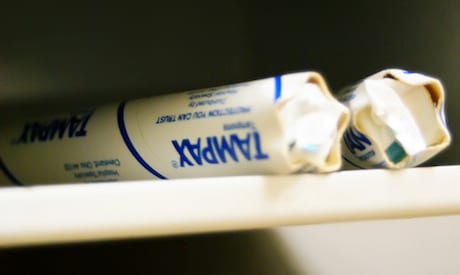
It’s been a big year for tampons and pads at Naturally Savvy. We already have more than 13,000 signatures on our Change.org petition asking Procter & Gamble to fully disclose what’s in their tampons and sanitary pads. I’m thrilled that so many of our readers are as passionate about this issue as I am. If you haven’t signed the petition yet, please take a look at my research study.
We’re asking P&G to label their tampons and sanitary pads because as a result of their classification as a medical device, full disclosure labeling isn’t required. So, why are tampons and pads considered medical devices anyway? My curiosity motivated me to take a closer look and what I found is a compelling story that makes me question the ethics of the feminine hygiene industry even more.
According to the FDA[1], a medical device is "an instrument, apparatus, implement, machine, contrivance, implant, in vitro reagent, or other similar or related article, including a component part, or accessory, which is:
• recognized in the official National Formulary, or the United States Pharmacopoeia, or any supplement to them,
• intended for use in the diagnosis of disease or other conditions, or in the cure, mitigation, treatment, or prevention of disease, in man or other animals, or
• intended to affect the structure or any function of the body of man or other animals, and which does not achieve any of its primary intended purposes through chemical action within or on the body of man or other animals and which is not dependent upon being metabolized for the achievement of any of its primary intended purposes."
Therefore, menstrual tampons and sanitary pads are considered medical devices because they are intended to affect the function of the body. The FDA has developed a guidance document to assist industry in preparing premarket notification submissions (510(k)) for menstrual tampons and pads that are subject to 510(k) requirements.
Read more about synthetic fibers in tampons
Tampons and TSS
But the story goes much deeper than just the definition of a medical device. As early as 1975 anecdotal evidence found that tampons caused Toxic Shock Syndrome (TSS), an illness that’s potentially deadly with symptoms that include fever, low blood pressure, skin rashes, and liver and kidney problems. Even still, manufacturers didn’t conduct research until five years later. In 1980, the CDC invited tampon manufacturers to Atlanta to look at wide ranging research on the subject. Manufacturers were asked to bring their own research but they didn’t have anything to show. Lawsuits years after showed that manufacturers knew about the link between high absorbency tampons and TSS and chose to ignore it.
In 1980, after 814 reported cases of TSS, the FDA classified tampons as Class II Medical Devices through The Federal Food, Drug, and Cosmetic Act (FDCA) and Medical Device Amendments (MDA). At that time, 97 percent of reported cases involved menstruating women. How could the industry know about this nasty illness and still not be upfront about it? In fact, P&G voluntarily pulled its Rely tampons when CDC studies showed that they had a higher statistical connection to TSS than other tampons tested.
Sign our Petition: Tell Procter & Gamble to Disclose What is in Their Feminine Hygiene Products
The FDA and other governing bodies around the world listed tampons as medical devices to force manufacturers to report adverse health effects to the end user. FDCA and MDA gave the FDA broad authority to regulate medical devices for safety and effectiveness. In June 1982, the FDA produced a final rule that tampons must carry a warning label. Later, an alert statement regarding tampons and TSS was added as a package insert.
Sanitary Pads: Lower Risk Medical Device
While sanitary pads are considered low risk medical devices by the FDA, the agency still has authority to regulate them for safety and effectiveness. It’s unclear when pads were classified as such, but the biggest concern with sanitary pads is the bleaching process. In a 1995 FDA Guidance, the agency recommended that pad manufacturers list the process of bleaching that they use to the FDA. TSS is not a concern with the use of menstrual pads.
Today’s sanitary pads and tampons include a range of ingredients from organic to chemical and while I am thankful that the FDA continues to categorize both tampons and sanitary pads as medical devices so they can regulate their safety, as consumers, we need full disclosure labeling to protect ourselves as well. You see, manufacturers weren’t forthright about what they put in their products in 1980. And today, 33 years later, they still want to hide their ingredients. I for one, think consumers have the right to know.
[1] We received this definition from the Morgan Liscinsky, a press officer in the FDA’s Office of Media Affairs.
Image: FotoGeekTerri










